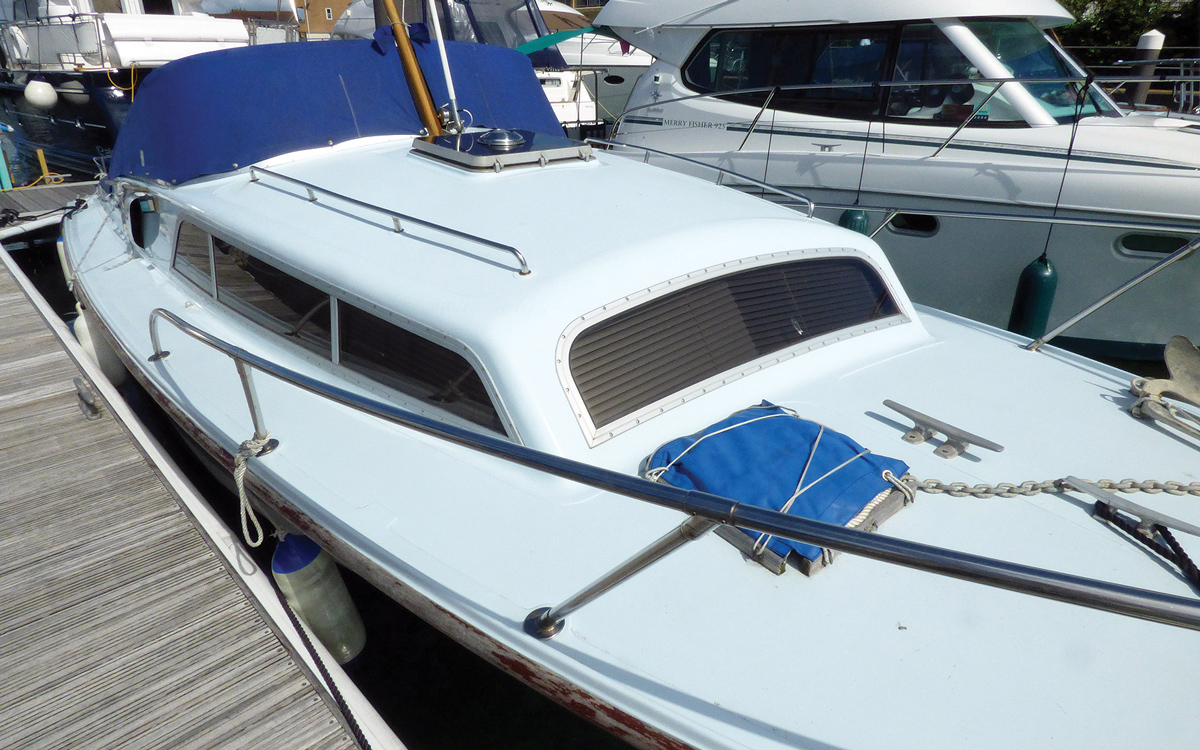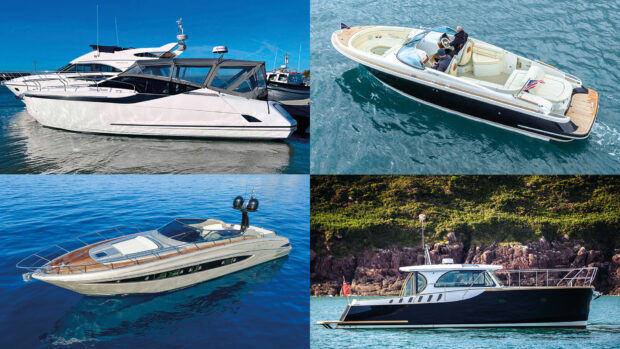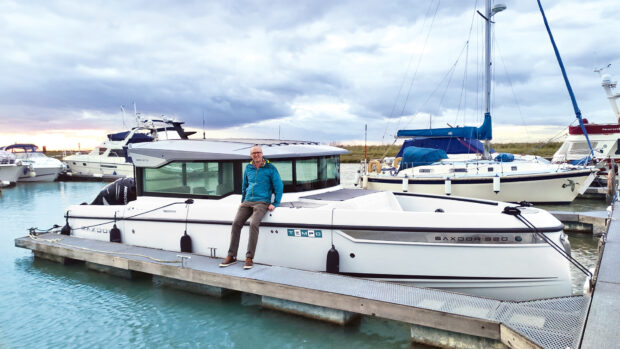Our resident used boat expert Nick Burnham picks out four used boats for sale for less than £80,000 from the likes of Fairline, Fairey, Trader and Carver.
It’s time for another price challenge! It’s always great to discover such a wide variation within a narrow price band by playing with the age and size and then tweaking it with more subjective matters like quality and desirability.
Doing an internet deep dive with a fictitious £80,000 this month has thrown up plenty of choice. There’s a rock-solid Taiwanese space ship, with its vast teak interior and air of indestructibility. There’s a lovely mainstream classic British flybridge 40(ish) footer that would tick a lot of boxes as a manageable family cruiser.
From the USA, hails an unusual blend of aft-cabin interior yet aft-cockpit exterior. And just to throw the cat among the penguins, a dyed-in-the-wool classic thoroughbred with a racing pedigree and rather more practicality than you might expect. Enjoy!

Trader 41+2
Built: 1990
Price: £74,950
Built in Taiwan, the 41 and 41+2 were mainstays of the Trader range and ran from 1979 to 2004. The ‘+2’ referred to the change from the original two-cabin version to a more popular three-cabin setup. There was also a 41 Sport that did away with the aft cabin altogether in favour of a low, deep cockpit.
Interior
The 41+2 is high, wide and has an aft-cabin layout, meaning that almost every inch of that length and beam is put toward palatial accommodation. On the forward lower deck you’ll find a vee berth guest cabin in the bow and that ‘+2’ third cabin with bunk beds to port. Both share a heads opposite. The saloon on the main deck splits this and the aft lower deck. Unusually, the galley is on the aft lower deck and it’s a good size. Finally, right at the stern is an excellent ensuite master cabin.

Offset berth frees up floor space in the traditional wood panelled aft cabin
Exterior
Another unusual feature is access to the outside. Normally aft-cabin boats have steps at the back of the saloon up to the aft deck. On the 41+2 you exit through one of the two sliding side doors onto the side decks and head forward or aft from here. You’ll find a couple of steps up to the massive aft deck, left clear but surrounded by GRP dodgers. A short run of further steps accesses the flybridge with its external helm position.
Performance
Early models had twin Ford Lehman diesel engines of 120hp, 135hp or 150hp, which gave about 11-12 knots flat out and an 8-knot cruise. Later boats got Volvo Penta TAMD 40 engines with 165hp pushing speeds to 14 knots. Finally Trader pushed power past 300hp with Caterpillar 3116 or Volvo Penta TAMD 61 motors. It’s the latter that this boat has, which pushed the top speed past 20 knots when new.

Saloon separates the forward cabins from the galley and owner’s suite further aft
Seakeeping
Solid and sturdy best describes the handling. It’s a reassuring boat in a big sea, although the bluff bows can throw up a fair amount of spray in rough weather.
Specification
Length: 41ft 2in (12.5m)
Beam: 14ft 0in (4.3m)
Draught: 4ft 0in (1.5m)
Displacement: 15 tonnes
Fuel capacity: 1,272 litres
Engines: Twin Volvo Penta TAMD61 306hp diesel engines
Contact: Boatshed Brighton
Article continues below…

Best boats under £50k: Secondhand options to expand your horizons

Best boats under £100,000 from the secondhand market
Fairline Phantom 38/41
Built: 1991
Price: £79,950
In the early Nineties, many manufacturers started to incorporate moulded-in bathing platforms to the hull rather than the traditional flat transom and bolt-on ‘shelf’. Soon after, the extra length of the platform began to be reflected in the model designation (which used to refer to the boat length only).
That’s why this Phantom 38 became the Phantom 41. However, just to confuse things, there was already a Fairline 41, which became the 43, and a 43, which became a 45. And later, Fairline introduced a new Phantom 38… (pay attention, there will be a test later)! Hence, the reason both model designations are often used.
Interior
Launched in 1991, the Phantom 38 had the classic circa 40ft flybridge interior layout of an ensuite master cabin in the bow and a twin-bunked second cabin with ensuite access to the day heads. The L-shaped galley is also on the lower deck. Up in the saloon there’s a raised twin-helm station to starboard with an L-shaped settee behind it. The height-adjustable table converts this area into an occasional third sleeping zone.

Classic 90s layout means the owner’s cabin and ensuite bathroom are up forward
Exterior
Along with the moulded-in bathing platform, the early Nineties also ushered in transom doors, present and correct in the centre of the transom on this boat. Access to the flybridge was still by ladder, but scaling it accesses a good-sized flybridge with a second helm position.
Performance
The ubiquitous twin Volvo Penta TAMD 61 306hp shaft-drive diesels that found themselves specced on just about everything circa 40ft in the Nineties are beneath the saloon floor. It’s interesting to compare the Performance with the Trader 41+2 though. Lighter, narrower and more easily driven, you could expect close to 30 knots from this boat when new.

The saloon dining area also converts into an occasional extra berth when needed
Seakeeping
This classic Bernard Olesinski planing hull has deep-vee forward sections segueing into a 19-degree deadrise aft for good head sea performance without losing the easy planing characteristics that give speed and fuel efficiency.
Specification
Length: 42ft 3in (12.9m)
Beam: 13ft 6in (4.1m)
Draught: 3ft 4in (1.0m)
Displacement: 10 tonnes
Fuel capacity: 1,091 litres
Engines: Twin Volvo Penta TAMD 61 306hp diesels
Contact: Clarke & Carter
Article continues below…
Get a quote for your next boat

Fairey Spearfish
Built: 1972
Price: £68,500
Fairey always comes to mind when discussing vintage powerboats. The big news with the Spearfish though, is that rather than the usual high-maintenance wooden construction, these were built out of that new-fangled GRP!
A development of the famed Fairey Huntsman, the mould was actually taken off an adapted wooden Huntsman hull. It’s a touch shorter at 30ft and a little lower, but taps directly into that boat’s race-proven deep-vee DNA. This particular boat was hull number 17.
Interior
The boat was developed very much as a ‘sporty dayboat or weekender’, so cabin accommodation is secondary. There are two berths and a removable table forward with the heads to port opposite a basic galley to starboard (a foot pump operated the fresh water system on the original boats).

Accommodation is limited but includes a vee-berth dinette, galley and heads
Exterior
The Spearfish is a beautifully proportioned boat and wears its classic heritage with pride. Decks are wide and flat and taper aft to wrap around the cockpit. The engine box protrudes through the cockpit sole, with the helm and double navigator seats in front of it and bench seats facing inwards behind it.
Performance
The £9,950 that these boats cost new included a pair of 145hp Perkins or 150hp Ford diesel engines spinning straight-shaft drives. Twin 175hp Ford engines were a £300 upgrade! This particular boat was re-engined in the early Nineties with a pair of Mermaid Majestic ‘Dover’ block 210bhp reconditioned diesel engines for a top speed of 30 knots and a mid-20-knot cruise.

A large engine box separates the forward helm area from the aft cockpit seating
Seakeeping
Designed, like all Faireys, by the legendary Alan Bunard, the Spearfish was developed using experience gathered from earlier boats, including regular sorties in the Cowes Torquay Cowes and Round Britain races of the time. Most notably, the bluff bows of early Huntsmen threw up a fair amount of spray in rough conditions, which is why this boat has a dramatically flared and raked bow (as did later Huntsmen).
Specification
Length: 30ft 0in (9.1m)
Beam: 9ft 6in (2.9m)
Draught: 3ft 0in (0.9m)
Displacement: 4.3 tonnes
Fuel capacity: 454 litres
Engines: Twin Mermaid Majestic 210hp diesel
Contact: Nicolle Associates

Carver 390
Built: 1994
Price: £77,950
With unashamedly North American styling, the Carver 390 hails from Wisconsin. It’s what our American cousins refer to as a Cockpit Motor Yacht – unusually, it has an aft cabin, a raised aft deck and a lower aft cockpit.
Interior
American cruisers have a reputation for being big, homely and spacious, and this is no exception. Interestingly for a mid-Nineties boat, when most manufacturers were still using teak, this interior uses pale maple, giving it a light, airy and contemporary feel. An unusual feature is a split-level main deck where the dinette is a step down to starboard, followed by further steps down to the galley.
The big American fridge freezer is present and correct and there’s a day heads here too. The forward cabin has another unusual feature, a ‘floating’ single berth above the double. Back aft is the ensuite master cabin.

The aft cabin has sliding doors out to a small cockpit area that feels like a private terrace
Exterior
It’s something never seen on European boats, but the big news is the small lower cockpit area tucked just behind the aft cabin. Sliding doors lead out to it from the master cabin, effectively making this a private balcony. A ladder leads from here up to the raised aft deck with a large GRP hardtop above it (another classic American feature). A couple of steps lead up again to the flybridge over the saloon.
Performance
When we originally tested the Carver 390, it was fitted with twin Mercruiser 7.3 litre V8 diesel engines (how appropriate). They gave a top speed of 26 knots and a 23-knot cruise. This boat has slightly smaller 250hp engines, so those speeds would be slightly lower.

Unusual split-level deck has the seating area, dinette and galley on three different levels
Seakeeping
Calm conditions stopped us from putting the boat through any serious challenges, but we were able to note that noise and vibrations were well muted, and the boat turned in about three boat lengths despite a long, shallow keel designed to aid stability rather than agility. Engine controls reportedly ‘fell nicely to hand’. Some things never change.
Specification
Length: 42ft 5in (12.9m)
Beam: 13ft 3in (4.0m)
Draught: 3ft 3in (1.0m)
Displacement: 11 tonnes
Fuel capacity: 1,287 litres
Engines: Twin Mercruiser 250hp diesels
Contact: Boats.co.uk
First published in the February 2021 issue of Motor Boat & Yachting.











